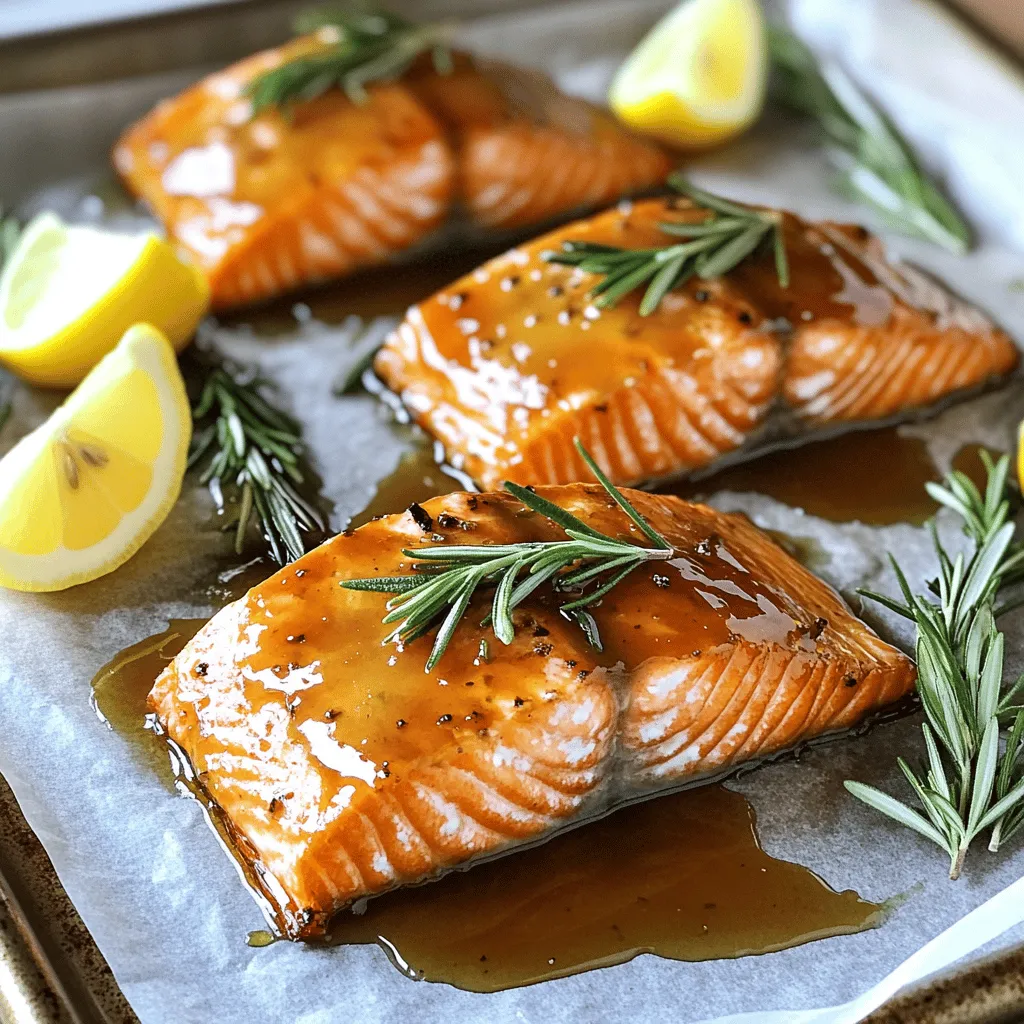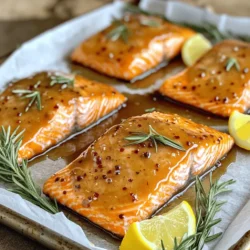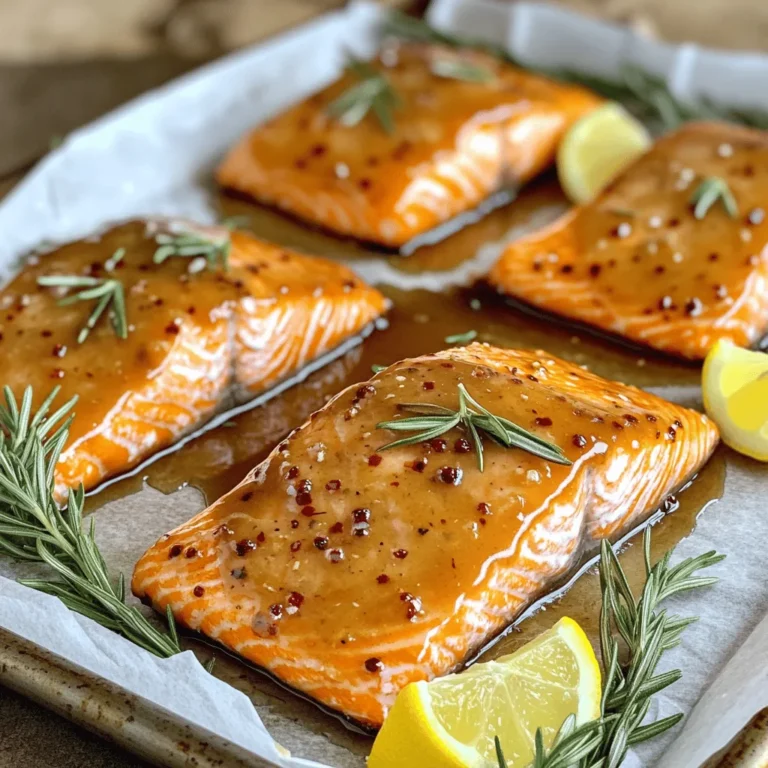Ready to impress your family with a delicious meal? This Maple Dijon Glazed Salmon recipe is easy and packed with flavor. With just a few simple ingredients and steps, you can create a dish that tastes gourmet. You’ll learn how to prepare the glaze, season the fish, and even tips for the perfect cook. Get ready to make this tasty salmon a new favorite at your dinner table!
Ingredients
Essential Components for Maple Dijon Glazed Salmon
To make the best maple Dijon glazed salmon, you need these key ingredients:
– 4 salmon fillets (about 6 ounces each)
– 1/4 cup pure maple syrup
– 2 tablespoons Dijon mustard
– 1 tablespoon extra virgin olive oil
– 2 cloves garlic, minced
– 1 teaspoon fresh rosemary, finely chopped
– Salt and freshly cracked black pepper, to taste
– Lemon wedges, for serving
Each ingredient plays a role. The salmon provides a rich, buttery flavor. Maple syrup adds sweetness, while Dijon mustard gives a tangy kick. Olive oil keeps it moist, and garlic adds depth.
Suggested Cuts of Salmon
I recommend using skin-on salmon fillets for this recipe. They stay juicy and flavorful while cooking. Wild-caught salmon is ideal because it has a better taste and is more sustainable. Farmed salmon is also good but may be fattier.
Fresh Herbs and Seasoning
Fresh herbs elevate this dish. I use rosemary, but you can try thyme or dill. Fresh herbs add brightness and aroma. Seasoning with salt and pepper enhances the flavor of the salmon. Don’t skip the lemon wedges for serving! They brighten the dish and balance the sweetness of the glaze.
Step-by-Step Instructions
Prepping the Oven and Baking Sheet
First, preheat your oven to 400°F (200°C). This step is crucial for even cooking. Next, line a baking sheet with parchment paper. This makes cleanup much easier.
Mixing the Maple Dijon Glaze
In a small bowl, mix together the following:
– 1/4 cup pure maple syrup
– 2 tablespoons Dijon mustard
– 1 tablespoon extra virgin olive oil
– 2 cloves garlic, minced
– 1 teaspoon fresh rosemary, finely chopped
Whisk these ingredients until smooth. This glaze adds sweet and tangy flavors to the salmon.
Seasoning the Salmon Fillets
Take your salmon fillets and season them with salt and freshly cracked black pepper. Make sure to coat both sides evenly. This simple step enhances the taste of the fish.
Baking Techniques for Perfect Salmon
Arrange the seasoned salmon skin-side down on the prepared baking sheet. This position helps the fish cook evenly. Generously brush each fillet with the maple Dijon glaze. Save some glaze for basting later.
Recommended Cooking Times and Doneness Indicators
Bake the salmon for about 12-15 minutes. It’s done when the fish flakes easily with a fork. For added moisture, baste the fillets with the reserved glaze halfway through baking. After baking, let the salmon rest for a couple of minutes. This allows the juices to settle. Serve hot with lemon wedges for a fresh burst of flavor. Enjoy your meal!
Tips & Tricks
How to Ensure the Salmon Doesn’t Dry Out
To keep your salmon juicy, always use a timer. Bake it for 12-15 minutes. If it flakes easily with a fork, it’s done. If you bake it too long, it dries out. Basting helps too. Apply the reserved glaze halfway through cooking. This keeps moisture in and adds flavor.
Best Practices for Flipping and Basting
Flipping salmon can be tricky. If you want to flip, use a spatula. Gently slide it under the fish. If you cook it skin-side down, flipping is not needed. Basting is key. Use the glaze to baste the fish halfway through cooking. This adds a nice layer of flavor.
Presentation Tips for Serving
Serve your salmon on a nice platter. Garnish with fresh rosemary and lemon slices. Drizzle any leftover glaze over the top. This adds shine and makes it look pretty. For a touch of color, you can add some green veggies on the side. A well-presented dish makes your meal feel special.

Variations
Alternative Glazes and Flavor Enhancements
You can switch things up with different glazes. Try honey instead of maple syrup for a sweet twist. Mix in soy sauce for a savory kick. A splash of orange juice adds a nice citrus flavor. Each change brings a new taste to your salmon.
Cooking Methods: Grilling vs Oven Baking
You can grill or bake your salmon. Grilling gives it a smoky flavor and beautiful grill marks. Just preheat your grill to medium heat. Place the salmon on foil to keep it from sticking. Baking is easier and keeps the fish moist. It’s perfect for busy nights. Both methods work well with the glaze.
Side Dishes that Pair Well with Maple Dijon Glazed Salmon
What should you serve with this dish? Here are some ideas:
– Roasted vegetables like asparagus or Brussels sprouts
– Quinoa or rice for a filling side
– A fresh salad with mixed greens and lemon vinaigrette
– Garlic mashed potatoes for a cozy meal
These sides complement the sweet and tangy flavors of the salmon. You can mix and match based on what you like. Enjoy your meal!
Storage Info
How to Store Leftover Salmon
Store your leftover salmon in an airtight container. This keeps it fresh for up to three days. Make sure it cools to room temperature before sealing. Label the container with the date for easy tracking.
Reheating Tips for Optimal Flavor and Texture
To reheat salmon, use your oven or a skillet. Preheat the oven to 275°F (135°C). Place the salmon on a baking sheet and cover it with foil. Heat for about 15 minutes. This method keeps it moist. If using a skillet, add a bit of water or broth to keep it from drying out. Heat on low to medium, flipping gently.
Freezing Maple Dijon Glazed Salmon: Best Practices
If you want to freeze the salmon, wrap each piece tightly in plastic wrap. Then, place them in a freezer bag. Remove as much air as possible to avoid freezer burn. Label the bag with the date. It can last up to three months in the freezer. To use, thaw in the fridge overnight before reheating.
FAQs
What is the best type of salmon to use for this recipe?
The best type of salmon for this recipe is wild-caught salmon. It has a richer flavor and firmer texture than farmed salmon. Sockeye and king salmon are top choices. They cook evenly and absorb flavors well. If you cannot find wild-caught, farmed salmon is also a good option.
Can I use store-bought maple syrup?
Yes, you can use store-bought maple syrup. Just make sure it is pure maple syrup and not imitation syrup. Pure maple syrup has a richer taste that blends well with the Dijon mustard in this glaze. It adds sweetness and depth to the dish.
How do I know when salmon is done cooking?
You can tell salmon is done when it flakes easily with a fork. The fish should be opaque and slightly firm to the touch. A good internal temperature is about 145°F (63°C). Use a meat thermometer for accuracy. If you do not have one, check for a slight translucence in the center.
Can I prepare the glaze in advance?
Yes, you can prepare the glaze in advance. Just store it in an airtight container in the fridge. It will stay fresh for up to three days. When you are ready to cook, give it a quick stir before using. This will help mix the flavors again.
What sides can I serve with maple Dijon glazed salmon?
Maple Dijon glazed salmon pairs well with many sides. Here are some options:
– Steamed asparagus
– Roasted sweet potatoes
– Quinoa salad
– Garlic mashed potatoes
– Green beans with almonds
These sides bring out the flavors of the glaze and make for a balanced meal.
Maple Dijon glazed salmon is a delicious dish. We covered ingredients, steps, tips, and variations. You learned how to choose salmon cuts, mix glazes, and bake perfectly. Remember to store leftovers properly for future meals. Experiment with flavors and sides to make it your own. With this guide, tasty salmon is within reach. Enjoy the process and impress your friends and family with your skills!


